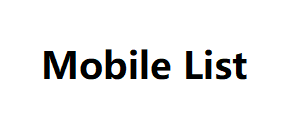Live chat proves to be a demand from consumers SMBs seem to continue to prioritize the phone as their primary point of contact with consumers. This is because, without taking into account self-service services, respondents stat that their companies mainly offer telephone support (88%). Two other main types of service offer are through Mobile List social networks (56%) and email via form (48%). The main channels use in SME customer service Bas on customer feedback, most companies intend to implement service via social networks (34%) and live chat with an agent (33%) in the future, which appear almost evenly. In the case of service via social networks, it can be carri out in real time, with an agent available to consumers, or via messages to be answer later.
Taking into account the first part
No wonder these supports appear in the spotlight. In the first part of the Capterra survey on customer service, 48% of consumers stat that chatting live with an agent (via the website or applications such as WhatsApp) would be their first choice for support, even surpassing telephone assistance ( 33%). Since the data points to a possible trend Iran Email List towards live chat, to create an operation with agents that respond in real time, it is worth considering the use of live chat software . This type of tool allows you to structure the operation, whether it is carri out on the company’s own page or through third-party platforms, such as WhatsApp or Messenger. Majority of employees said their company investigates the source of negative feedback Knowing the customer’s opinion about the service can serve as a starting point for the improvement of the sector.
Knowing the customer’s opinion
Some Brazilian SMEs seem to understand this, as only 8% of Capterra respondents pointed out that their employer does not collect or monitor customer feedback. When it comes to investigating consumer opinion, SMEs show that they get feedback on service mainly through a satisfaction survey sent by email (45%), according to their employees. Next, many also monitor comments on social networks (43%). Of those who collect feedback, according to employees, 68% say they receive mostly positive feedback, only 3% said they receive negative feedback. Taking into account the first part of the Capterra study, this could be a result of the fact that consumers are motivat to leave reviews especially when face with a positive situation, as shown in the graph below.

